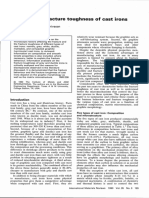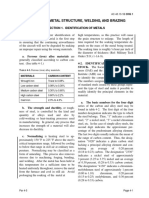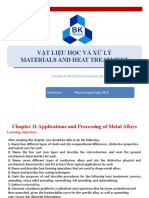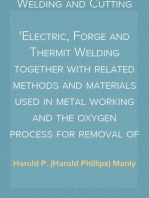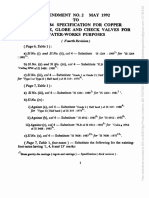Guide Welding Iron Castings: 1. Scope and History
Guide Welding Iron Castings: 1. Scope and History
Uploaded by
Paola CernaCopyright:
Available Formats
Guide Welding Iron Castings: 1. Scope and History
Guide Welding Iron Castings: 1. Scope and History
Uploaded by
Paola CernaOriginal Description:
Original Title
Copyright
Available Formats
Share this document
Did you find this document useful?
Is this content inappropriate?
Copyright:
Available Formats
Guide Welding Iron Castings: 1. Scope and History
Guide Welding Iron Castings: 1. Scope and History
Uploaded by
Paola CernaCopyright:
Available Formats
ANSVAWS D11.
2-89 (R2006)
Guide for
Welding Iron Castings
1. Scope and History base electrodes and rods were developed and are still in
use today.
1.1 Scope. The term cast iron encompasses a family of
New, more refined welding processes and procedures
ferrous alloys with a variety of metallurgical, mechani-
were developed to extend greatly the number of applica-
cal, and physical properties. The chemical composition
tions where welding is used. Shielded metal arc (SMAW),
and welding requirements of the metals vary within the
gas metal arc (GMAW), flux cored arc (FCAW) and
family. This document discusses the relative weldability
submerged arc (SAW) welding currently are popular arc
of various types of cast irons and the filler metals and
welding processes.
processes used to weld them. It recommends the steps for
Gas tungsten arc (GTAW) and proprietary processes
qualification of welding procedures, welding operators
are used in a variety of applications.
and welders, and requirements for the quality of welds.
2. Cast Iron - Its Metallurgy and
The terms welding procedure, welding operator, and
welder, are used as defined in the latest edition of ANSI/
AWS A3.0, Standard Welding Terms and Definitions. Weldability
1.2 History 2.1 Metallurgy
1.2.1 Types of Iron. Although iron has been used in 2.1.1 General. Cast iron may be described as an alloy
various forms for over two thousand years, iron castings of iron, carbon and silicon. All commercially produced
in the form used today evolved in Europe in the 15th and irons also contain manganese. They may be alloyed with
16th centuries. The microstructure of medieval castings nickel, chromium, copper, molybdenum, tin, antimony,
basically was gray iron with areas of white iron and vanadium, and other elements. The alloying elements
nonmetallic inclusions. Refinements in foundry practi- may be present individually or in combination.
ces and melt control resulted in a more uniform structure. The carbon content is in excess of the quantity that
Malleabilizing, a method of increasing the ductility of can be retained in solid solution by austenite. Thus,
white cast iron by heat treatment, was first developed in during solidification, a portion of the carbon separates
the early 1700’s. About a century later, black heart mal- from the melt as either iron carbide (Fe,C) or graphite. If
leable iron was developed. the cooling rate is rapid, the carbon rich phase will be
In the 19405, ductile (spheroidal graphite) iron was iron carbide. Elemental carbon (graphite) precipitates if
developed. The ductility is improved by spherodizing the the cooling rate is slow enough. The type of carbon
graphite by the addition of magnesium, rare earth ele- constituent and its shape (if graphite), in part, determines
ments, or both. the type and properties of cast iron. The phases present
The most recently developed form of cast iron is com- in the matrix also affect the properties; therefore, the
pacted graphite, a hybrid material with properties entire microstructure of the casting must be considered
between gray and ductile irons. when planning a suitable welding procedure.
1.2.2 Welding. Oxyfuel gas and arc welding of cast 2.1.2 Gray Iron. The most commonly used form of
iron did not gain wide acceptance until early in the 20th cast iron is gray iron. In this material, the excess carbon
century. The first filler metals were cast along with the precipitates as flakes of graphite in a matrix of ferrite,
iron castings so that the compositions were similar. pearlite, or a mixture of the two microconstituents (see
Later, both ferrous and nonferrous (copper or nickel) Figure 1). The resultant product has moderate strength,
You might also like
- Guide Welding Iron Castings: 1. Scope and HistoryDocument14 pagesGuide Welding Iron Castings: 1. Scope and HistoryPaola CernaNo ratings yet
- 1990ASM - Handb - Vol1 - Classification and Basic Metallurgy of Cast IronDocument10 pages1990ASM - Handb - Vol1 - Classification and Basic Metallurgy of Cast IronFátima GouveiaNo ratings yet
- Vermicular GraphiteDocument12 pagesVermicular GraphiteUyên QuáchNo ratings yet
- ASM 4E - Chapter Cu and Alloys1Document14 pagesASM 4E - Chapter Cu and Alloys1Rudrash Biradar50% (2)
- Copper Alloys For Marine EnvironmentsDocument32 pagesCopper Alloys For Marine EnvironmentsMohamed FaragNo ratings yet
- 1990ASM Handb vol1CastIr classifDMSDocument10 pages1990ASM Handb vol1CastIr classifDMSJhon CarvajalNo ratings yet
- Rehabilitation of Steel Structures C1Document37 pagesRehabilitation of Steel Structures C1Alina CiuraruNo ratings yet
- High Speed SteelsDocument40 pagesHigh Speed SteelsMarcelo SantanaNo ratings yet
- Copper Welding ProcedureDocument7 pagesCopper Welding ProcedureCharles JacobNo ratings yet
- Welding Cast Iron PDFDocument15 pagesWelding Cast Iron PDFAmr Mohamed SolimanNo ratings yet
- Copper and Copper AlloysDocument19 pagesCopper and Copper AlloysYousef Adel HassanenNo ratings yet
- Welding Cast Irons CottrelDocument32 pagesWelding Cast Irons CottrelArvind KumarNo ratings yet
- E Book On SS WeldingDocument71 pagesE Book On SS WeldingNiranjan Rajavel TigerNo ratings yet
- Classification and Application of Plain Carbon Steels: January 2019Document15 pagesClassification and Application of Plain Carbon Steels: January 2019vikas palla100% (1)
- Shreya S 2019Document8 pagesShreya S 2019Ilmal YaqinNo ratings yet
- 14250A ch1 PDFDocument25 pages14250A ch1 PDFnagarajNo ratings yet
- 1982AustSS FSWeldJntFalrs WeldJDocument11 pages1982AustSS FSWeldJntFalrs WeldJthisaintwapNo ratings yet
- Baker 2015 Microalloyed SteelsDocument45 pagesBaker 2015 Microalloyed SteelsHumbertzone O. Garcia CedilloNo ratings yet
- An Explanation of Possible Damascus Steel Manufacturing Based On Duration of Transient Nucleate Boiling ProcessDocument7 pagesAn Explanation of Possible Damascus Steel Manufacturing Based On Duration of Transient Nucleate Boiling ProcessHX2No ratings yet
- Materials and Design: Danial Kianersi, Amir Mostafaei, Ahmad Ali AmadehDocument13 pagesMaterials and Design: Danial Kianersi, Amir Mostafaei, Ahmad Ali AmadehKhalid HafezNo ratings yet
- Duplex Stainless Steel 2d Edition PracticalDocument64 pagesDuplex Stainless Steel 2d Edition Practicalmahmoud_allam3100% (1)
- Testing of Austenitic Stainless SteelsDocument64 pagesTesting of Austenitic Stainless SteelsmirelamanteamirelaNo ratings yet
- A Review On Tests of Austempered Ductile IronDocument8 pagesA Review On Tests of Austempered Ductile Ironmoh salemNo ratings yet
- Embrittlement of SteelDocument8 pagesEmbrittlement of SteelMarjan SubanNo ratings yet
- Ferrous and Non-Ferrous Metals: Intended Learning OutcomesDocument83 pagesFerrous and Non-Ferrous Metals: Intended Learning OutcomesJingness StanNo ratings yet
- United States Patent 19: Roper, Jr. Et AlDocument4 pagesUnited States Patent 19: Roper, Jr. Et AlMada TetoNo ratings yet
- Classification of Metallic Engineering MaterialsDocument24 pagesClassification of Metallic Engineering MaterialsidontlikeebooksNo ratings yet
- Dissimilar Welding of AISI 309 Stainless Steel To AISI 1020 Carbon Steel Using Arc Stud WeldingDocument6 pagesDissimilar Welding of AISI 309 Stainless Steel To AISI 1020 Carbon Steel Using Arc Stud WeldingFiras RocktNo ratings yet
- Copper - Alloys - Properties and Applications - ChapterDocument5 pagesCopper - Alloys - Properties and Applications - ChapterJavier RodenasNo ratings yet
- Carrera Profesional de Ingenieria CivilDocument21 pagesCarrera Profesional de Ingenieria CivilfelixNo ratings yet
- An Explanation of Possible Damascus Steel Manufacturing Based On Duration of Transient Nucleate Boiling Process and Prediction of The Future of Controlled Continuous CastingDocument9 pagesAn Explanation of Possible Damascus Steel Manufacturing Based On Duration of Transient Nucleate Boiling Process and Prediction of The Future of Controlled Continuous CastingAmanpreet singhNo ratings yet
- Guidelines FieldWeldingandCutting PDFDocument11 pagesGuidelines FieldWeldingandCutting PDFYahirEduardoNavarroKauilNo ratings yet
- Curso Marnha AmericanaDocument1,244 pagesCurso Marnha AmericanaSergio Augusto FernandesNo ratings yet
- Creep Performance and Microstructure Characterization of Electron-Beam Welded 316LNSS-Grade 91 Steel Dissimilar JointDocument16 pagesCreep Performance and Microstructure Characterization of Electron-Beam Welded 316LNSS-Grade 91 Steel Dissimilar JointwangpengstpNo ratings yet
- Oxy-Acetylene Welding and CuttingDocument96 pagesOxy-Acetylene Welding and CuttingGutenberg.orgNo ratings yet
- Materi Pertemuan Ke 4. Pengelasan FCAWDocument31 pagesMateri Pertemuan Ke 4. Pengelasan FCAWRaihan Arrafi10No ratings yet
- Metallurgical Properties of Cast IronsDocument21 pagesMetallurgical Properties of Cast IronsAleš NagodeNo ratings yet
- Unit 2Document65 pagesUnit 2iasdurgeshtrivediNo ratings yet
- Metals And: AlloysDocument26 pagesMetals And: AlloysJorge RamirezNo ratings yet
- Study of Mechanical Properties of Zn-27Al Alloy Cast in Metal Mould at Different Casting ConditionsDocument4 pagesStudy of Mechanical Properties of Zn-27Al Alloy Cast in Metal Mould at Different Casting ConditionserpublicationNo ratings yet
- Duplex SS HistoryDocument7 pagesDuplex SS HistoryPedro CarneiroNo ratings yet
- Ape Lian 1981Document9 pagesApe Lian 1981gegegegNo ratings yet
- Fracture and Fracture Toughness of Cast Irons: W. L. Bradley and M. N. SrinivasanDocument33 pagesFracture and Fracture Toughness of Cast Irons: W. L. Bradley and M. N. SrinivasanNarasimha Murthy InampudiNo ratings yet
- The National Board of Boiler and Pressure Vessel InspectorsDocument3 pagesThe National Board of Boiler and Pressure Vessel Inspectorsmiguel arandaNo ratings yet
- Páginas de Steel Structutures PDFDocument75 pagesPáginas de Steel Structutures PDFWilliam PolNo ratings yet
- Alloy CarbidesDocument2 pagesAlloy Carbidesmp87_ing100% (1)
- ND YAG Laser Beam Welding of UNS N07718 Superalloy and UNS S32304Document17 pagesND YAG Laser Beam Welding of UNS N07718 Superalloy and UNS S32304icsea2021No ratings yet
- Lab 4 Material Sci and EngDocument7 pagesLab 4 Material Sci and EngMahmoud Mohamed 202201119No ratings yet
- Steel 3Document13 pagesSteel 323je0114No ratings yet
- Section 1. Identification of MetalsDocument4 pagesSection 1. Identification of MetalsrobinyNo ratings yet
- Gas Metal Arc Welding ElectrodeDocument1 pageGas Metal Arc Welding Electrodeadib nassarNo ratings yet
- Adegoloye Et Al. - 2015 - Concretes Made of EAF Slag and AOD Slag Aggregates From Stainless Steel Process Mechanical Properties and DuraDocument9 pagesAdegoloye Et Al. - 2015 - Concretes Made of EAF Slag and AOD Slag Aggregates From Stainless Steel Process Mechanical Properties and DuraNguyen Thanh CuongNo ratings yet
- PQT Chapter 11 Applications and Processing of Metal AlloysDocument30 pagesPQT Chapter 11 Applications and Processing of Metal AlloysNguyễn Việt TiếnNo ratings yet
- Oxy-Acetylene Welding and Cutting: Electric, Forge and Thermit Welding together with related methods and materials used in metal working and the oxygen process for removal of carbonFrom EverandOxy-Acetylene Welding and Cutting: Electric, Forge and Thermit Welding together with related methods and materials used in metal working and the oxygen process for removal of carbonRating: 4 out of 5 stars4/5 (1)
- The Working of Steel Annealing, Heat Treating and Hardening of Carbon and Alloy SteelFrom EverandThe Working of Steel Annealing, Heat Treating and Hardening of Carbon and Alloy SteelRating: 5 out of 5 stars5/5 (4)
- The Working of Steel: Annealing, Heat Treating and Hardening of Carbon and Alloy SteelFrom EverandThe Working of Steel: Annealing, Heat Treating and Hardening of Carbon and Alloy SteelNo ratings yet
- Forging - Manual of Practical Instruction in Hand Forging of Wrought Iron, Machine Steel and Tool Steel; Drop Forging; and Heat Treatment of Steel, Including Annealing, Hardening and TemperingFrom EverandForging - Manual of Practical Instruction in Hand Forging of Wrought Iron, Machine Steel and Tool Steel; Drop Forging; and Heat Treatment of Steel, Including Annealing, Hardening and TemperingRating: 5 out of 5 stars5/5 (1)
- Oxy-Acetylene Welding and Cutting Electric, Forge and Thermit Welding together with related methods and materials used in metal working and the oxygen process for removal of carbonFrom EverandOxy-Acetylene Welding and Cutting Electric, Forge and Thermit Welding together with related methods and materials used in metal working and the oxygen process for removal of carbonNo ratings yet
- Sheet Metalwork on the Farm - Containing Information on Materials, Soldering, Tools and Methods of Sheet MetalworkFrom EverandSheet Metalwork on the Farm - Containing Information on Materials, Soldering, Tools and Methods of Sheet MetalworkNo ratings yet
- Standard Methods For Mechanical Testing of WeldsDocument2 pagesStandard Methods For Mechanical Testing of WeldsPaola CernaNo ratings yet
- AwsweldingsuperupdateDocument19 pagesAwsweldingsuperupdatePaola CernaNo ratings yet
- Supplement F - Chemical Plant and Petroleum Refinery Piping: American Welding SocietyDocument24 pagesSupplement F - Chemical Plant and Petroleum Refinery Piping: American Welding SocietyPaola CernaNo ratings yet
- ANSI AWS C6.1-89 Recommended Practices For Friction WeldingDocument38 pagesANSI AWS C6.1-89 Recommended Practices For Friction WeldingPaola CernaNo ratings yet
- ServiciosCOMIMSA2019 EnglishDocument24 pagesServiciosCOMIMSA2019 EnglishPaola CernaNo ratings yet
- 308L StainlessSteel 62Document1 page308L StainlessSteel 62Paola CernaNo ratings yet
- Course RulesDocument11 pagesCourse RulesPaola CernaNo ratings yet
- Steel GradesDocument32 pagesSteel GradesAnoop R.KNo ratings yet
- Galvanizing ProcedureDocument11 pagesGalvanizing ProcedureMcmiltondmordomNo ratings yet
- Technical Data Sheet Brazetec 3075: InhaltDocument1 pageTechnical Data Sheet Brazetec 3075: InhaltGianni BaroniNo ratings yet
- Experimental Investigation of Machining Parameters For Aluminum 6061 T6 AlloyDocument6 pagesExperimental Investigation of Machining Parameters For Aluminum 6061 T6 AlloyEditor IJTSRDNo ratings yet
- TO Is 778: 1984 Specification For Copper Alloy Gate, Globe and Check Valves For Water-Works PurposesDocument2 pagesTO Is 778: 1984 Specification For Copper Alloy Gate, Globe and Check Valves For Water-Works PurposesThetarunNo ratings yet
- CNC Worksheet - djj40142 Mechanical Workshop Practice 4Document7 pagesCNC Worksheet - djj40142 Mechanical Workshop Practice 4DKM3C-F1056-PRAVINESHNo ratings yet
- Astm F436M PDFDocument5 pagesAstm F436M PDFEnrique AntonioNo ratings yet
- St. John'S School Greater Noida WestDocument3 pagesSt. John'S School Greater Noida WestIndia Tech with AstitvaNo ratings yet
- Katalog 4 Innen ESDocument13 pagesKatalog 4 Innen ESCsapai CristianaNo ratings yet
- 06Document8 pages06rat12345No ratings yet
- Astm A957 A957m 13Document6 pagesAstm A957 A957m 13Diego CanilNo ratings yet
- AEC MC007 Beam Clamps Straps Clamps Clamp Backs RMC IMCDocument3 pagesAEC MC007 Beam Clamps Straps Clamps Clamp Backs RMC IMCwane-chanNo ratings yet
- A999a999m 17Document12 pagesA999a999m 17AFQBAVQ2EFCQF31FNo ratings yet
- Service Manual Harman Kardon AVR-1500Document74 pagesService Manual Harman Kardon AVR-1500aliarroNo ratings yet
- Evaluación de Los Factores de Biolixiviacion para Recuperacion de Oro Mediante Bacterias CianogenicasDocument5 pagesEvaluación de Los Factores de Biolixiviacion para Recuperacion de Oro Mediante Bacterias CianogenicasSergioLymNo ratings yet
- Metal Corrosion and Its Prevention Part - 2Document13 pagesMetal Corrosion and Its Prevention Part - 2Aman NikhareNo ratings yet
- Alloys, Melting PointDocument2 pagesAlloys, Melting PointkieunkimNo ratings yet
- Metalwork JapanDocument18 pagesMetalwork JapanGuadalupeCaravajal100% (1)
- AWS Electrode ClassificationsDocument3 pagesAWS Electrode ClassificationsUsamaIjaz100% (1)
- Experimental Study On Concrete Using Copper Slag As Fine Aggregate With Bacterial Admixture Ashok.C1, Ravishankar.D2, Devaraj.M3, Saravanan.S4Document5 pagesExperimental Study On Concrete Using Copper Slag As Fine Aggregate With Bacterial Admixture Ashok.C1, Ravishankar.D2, Devaraj.M3, Saravanan.S4GR DesignsNo ratings yet
- Wa0001Document1 pageWa0001sanyam100704No ratings yet
- S.T.E.M: Unit Plan For SemesterDocument23 pagesS.T.E.M: Unit Plan For SemesterDavid DowningNo ratings yet
- Mechanical Properties of SteelDocument1 pageMechanical Properties of SteelrianrureNo ratings yet
- D 1732 - 67 R98 - Rde3mzitukveDocument10 pagesD 1732 - 67 R98 - Rde3mzitukveHans AbantoNo ratings yet
- Metal PressworkDocument32 pagesMetal PressworkLihle Ayabonga NcambacaNo ratings yet
- Belgaum Foundry ClusterDocument19 pagesBelgaum Foundry ClusterVinay Vasant Mangale0% (1)
- Steel Tubes For Mechanical AND Genewl Eng Eewg Purposes - SpecificationDocument20 pagesSteel Tubes For Mechanical AND Genewl Eng Eewg Purposes - SpecificationSajal DeyNo ratings yet
- Schiavi Enc Met Page092Document1 pageSchiavi Enc Met Page092Adel AdelNo ratings yet
- Engineering Material Specification: Printed Copies Are UncontrolledDocument6 pagesEngineering Material Specification: Printed Copies Are UncontrolledChandrajeet ShelkeNo ratings yet
- ASTM B221M - 05a V2006 Standard Specification For Aluminum and Aluminum-Alloy Tubes, ProfilesDocument14 pagesASTM B221M - 05a V2006 Standard Specification For Aluminum and Aluminum-Alloy Tubes, Profilesenrique_herrediaz6279No ratings yet










































